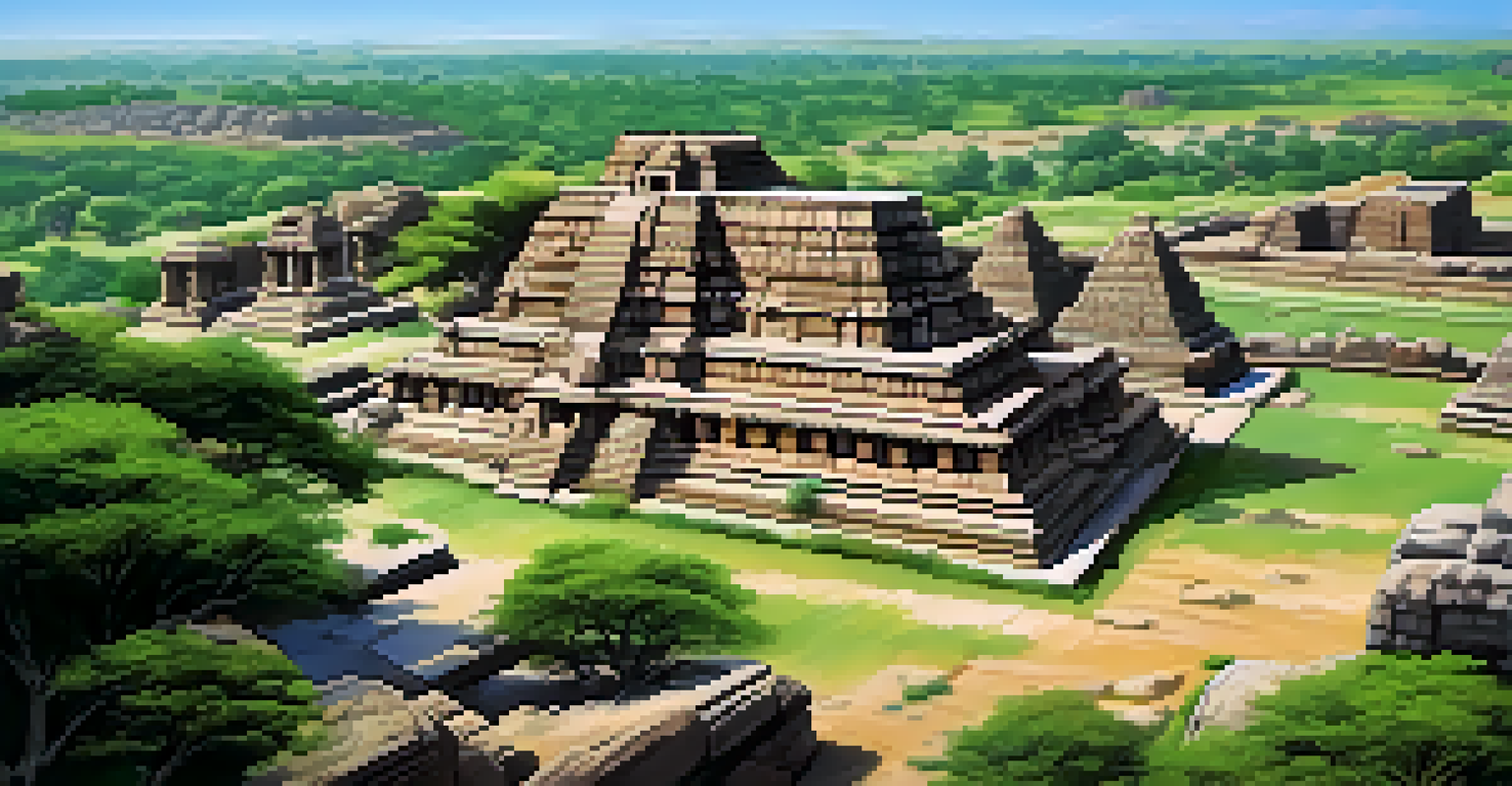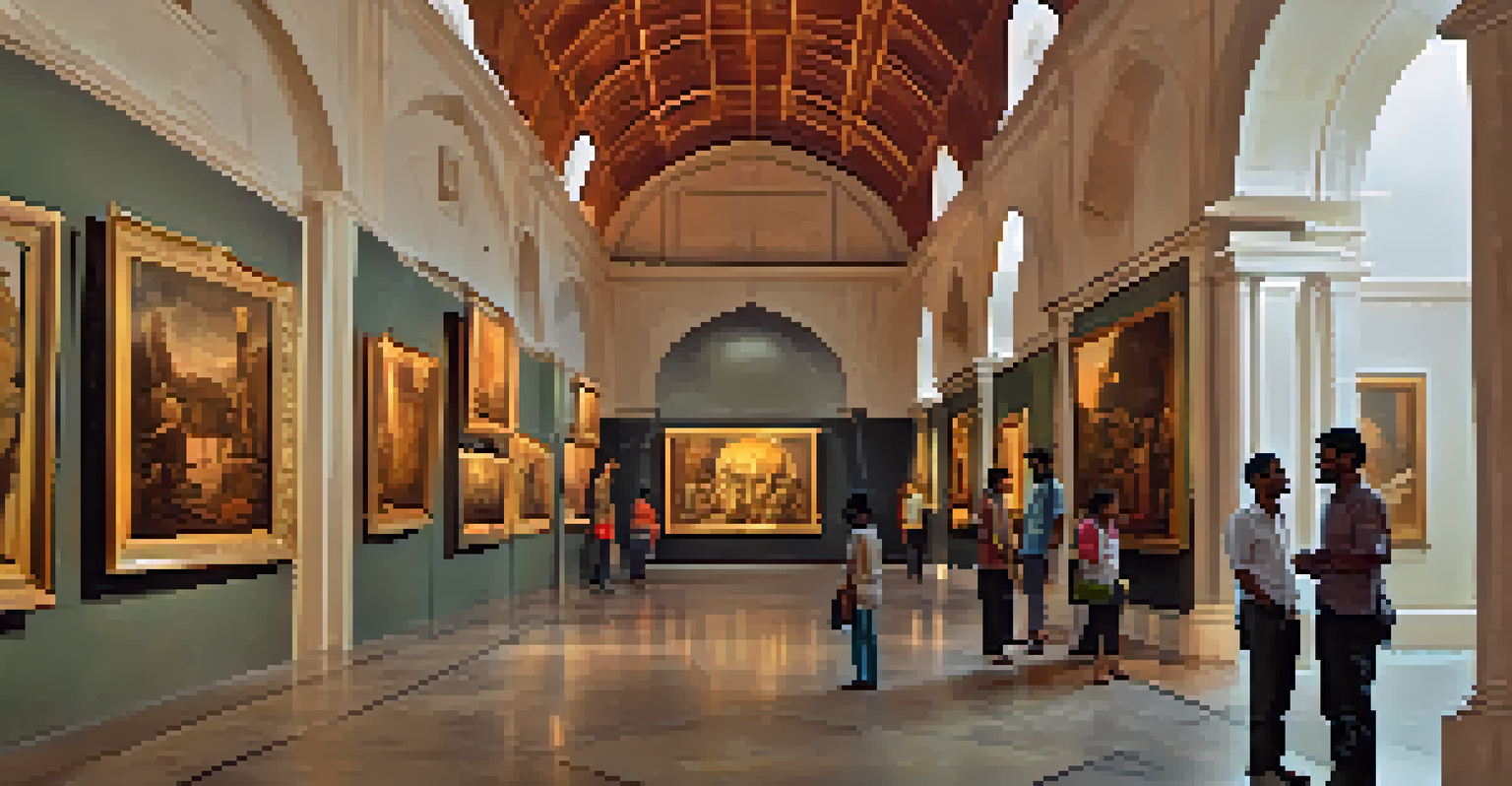A Guide to India's Most Educational Heritage Centers

Exploring the Wonders of the Taj Mahal: A Symbol of Learning
The Taj Mahal, often celebrated for its stunning architecture, also serves as a testament to India's rich educational history. Built in the 17th century, this UNESCO World Heritage site is not just a mausoleum but also a hub for historians and scholars alike. Visitors can learn about the Mughal Empire's advanced architectural techniques and the cultural exchanges that shaped Indian history.
The more I read, the more I acquire, the more certain I am that I know nothing.
As you walk through its grand gardens and intricate marble inlay work, you'll discover stories that go beyond beauty. The Taj Mahal provides insights into the importance of love, loss, and the artistic pursuits of the era. Educational programs and guided tours help visitors understand the historical context and significance of this iconic structure.
Moreover, the Taj Mahal inspires countless art and literature enthusiasts, encouraging them to delve deeper into Mughal history. It’s a place where education meets inspiration, making it a must-visit for anyone interested in India’s heritage.
Hampi: The Ruins of a Once-Thriving City
Hampi, a UNESCO World Heritage site, is a mesmerizing reminder of the Vijayanagara Empire's grandeur. The site is dotted with ancient temples, royal complexes, and market streets that echo the vibrant history of this once-thriving city. Exploring Hampi is like stepping back in time, offering lessons in architecture, culture, and the socio-economic fabric of 14th-century India.

As you wander through the ruins, you can learn about the innovative engineering techniques used to construct structures like the iconic Virupaksha Temple. Educational tours often include storytelling sessions that weave together the mythology and history of Hampi, engaging visitors on multiple levels. Each stone has a tale to tell, making history come alive.
Taj Mahal: A Hub for Learning
Beyond its beauty, the Taj Mahal serves as an educational resource, offering insights into Mughal history and architecture.
Hampi also encourages archaeological studies and research, attracting scholars from around the world. This blend of exploration and education makes Hampi a true gem for those interested in India's heritage.
Kolkata's Indian Museum: A Treasure Trove of Knowledge
The Indian Museum in Kolkata is the oldest and one of the largest museums in India, making it a cornerstone of educational heritage. With exhibits ranging from ancient sculptures to rare fossils, the museum offers a comprehensive look at India's cultural and scientific history. Each gallery provides insights into various disciplines, from anthropology to geology, making it an invaluable resource for learners of all ages.
Education is the most powerful weapon which you can use to change the world.
Visiting the museum can spark curiosity and inspire future generations of historians, scientists, and artists. The museum frequently hosts workshops, lectures, and exhibitions that encourage community engagement and education. These programs help visitors connect with the artifacts on display and understand their significance in a broader context.
The Indian Museum is not just a place to view artifacts; it’s a place to learn, explore, and question. It's a perfect example of how heritage centers can serve as educational hubs in a modern world.
Jaipur’s Amer Fort: History and Culture Combined
Amer Fort in Jaipur stands as a magnificent example of Rajput architecture, blending history and culture in every corner. This fort, with its grand courtyards and intricate carvings, offers visitors a glimpse into the royal lifestyle of the past. Educational tours here often highlight the fort's strategic importance and its role in the region's history, providing a deeper understanding of Rajasthan's heritage.
As you traverse its winding pathways, you’ll discover fascinating stories of valor, art, and architecture. The fort also offers various cultural programs, including traditional music and dance performances, immersing visitors in the local culture. These experiences enrich the educational journey, making history tangible and relatable.
Hampi: Echoes of a Grand Empire
Hampi’s ruins provide a fascinating glimpse into the Vijayanagara Empire, blending history, culture, and innovative engineering.
Amer Fort is more than just a historical site; it’s an interactive learning experience that captivates the imagination. It encourages visitors to appreciate the rich tapestry of Indian heritage in a fun and engaging way.
Mysore Palace: A Lesson in Royal History
The Mysore Palace is an architectural marvel that embodies the grandeur of the Wodeyar dynasty. This heritage center is not only a tourist attraction but also a valuable educational site that teaches visitors about royal traditions, art, and culture. The palace showcases a blend of Gothic, Indo-Saracenic, and Baroque styles, illustrating the evolution of architecture in India.
Guided tours often share stories about the palace's history, including its role in the Dasara festival, which celebrates the victory of good over evil. Visitors can also engage with local artisans who demonstrate traditional crafts, providing a hands-on learning experience that highlights the importance of preserving cultural heritage.
Mysore Palace stands as a testament to the richness of Indian history, reminding us of the stories woven into its walls. It’s a fantastic place to learn about the past while enjoying the beauty of architectural artistry.
The Khajuraho Temples: A Study in Art and Spirituality
The Khajuraho Temples are famous for their stunning sculptures and intricate carvings, representing the pinnacle of Indian temple architecture. These UNESCO World Heritage sites offer a unique educational experience, focusing on artistry, spirituality, and the cultural ethos of ancient India. Each temple tells a story through its carvings, depicting various aspects of life, love, and spirituality.
Visitors can participate in guided tours that delve into the significance of the sculptures and the symbolism behind them. The temples reflect a philosophy that intertwines art with spirituality, prompting discussions about the role of art in religion and society. This makes Khajuraho not just a visual feast but also a profound learning experience.
Khajuraho: Art Meets Spirituality
The Khajuraho Temples showcase intricate sculptures that highlight the relationship between art and spirituality in ancient India.
Exploring these temples invites reflection on the complexities of human existence and the celebration of love in its many forms. Khajuraho stands as a testament to India's rich artistic heritage, captivating the hearts and minds of all who visit.
Rani Ki Vav: An Engineering Marvel from the Past
Rani Ki Vav, a stepwell located in Patan, Gujarat, is a brilliant example of ancient engineering and artistry. This UNESCO World Heritage site not only provided water storage but also served as a social and cultural hub for the community. Its intricate sculptures and carvings offer a wealth of knowledge about the craftsmanship of the Solanki period, making it an educational treasure trove.
As you descend the steps of Rani Ki Vav, you are greeted by beautifully carved panels that depict various deities and mythological stories. Educational programs here often focus on the engineering techniques used in its construction, showcasing the ingenuity of ancient architects. This combination of art and function offers a unique perspective on how water management was intertwined with daily life.

Rani Ki Vav invites visitors to appreciate the harmony between utility and beauty in ancient architecture. It’s a reminder of how heritage sites can enlighten us about sustainable practices from the past.